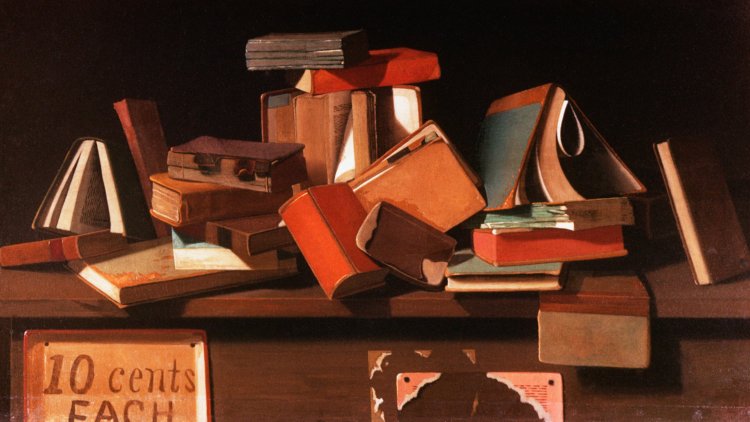Will Publishing’s Diversity Gains Last?
Published works of fiction by nonwhite authors more than doubled from 2019 to 2023—but we may now be seeing a reversal in this trend.

This is an edition of the Books Briefing, our editors’ weekly guide to the best in books. Sign up for it here.
After the 2020 murder of George Floyd, the United States experienced what was widely referred to as a “reckoning” with racism. The book industry was not exempt—pushed by protests against what employees called the industry’s “role in systemic racism,” major publishers promised to confront their overwhelming whiteness by hiring employees of color and acquiring books by nonwhite authors.
This week, we published an article by the English professors Dan Sinykin and Richard Jean So, in which they reflect on a survey they conducted from 2019 to 2023 that tracks the proportion of novels published by white versus nonwhite authors. They found that published works of fiction by nonwhite authors more than doubled in the period studied—but noted that similar waves of diversity efforts in publishing in the past haven’t lasted long. As Sinykin and So write, although the results reflect progress, “they also demand that we reckon with what appears now to be the beginning of their reversal—and contemplate what can be done to avoid a seemingly inevitable cycle of retrenchment following any progress.”
This week, I emailed Sinykin and So to ask a few more questions about their research. Our conversation, which has been condensed and edited for clarity, is below.
First, here are three new stories from The Atlantic’s Books section:
- What to read to understand how people get tricked
- The truth about America’s most common surgery
- The enduring fascination with women in water
Maya Chung: You mention two previous waves of diversification of the publishing industry in the late 1960s and early ’70s, and the late ’90s and early 2000s, that ultimately didn’t have lasting success—and that this one is different because of the volume of titles by writers of color being published. Are there any other differences this time that give us reason to be hopeful?
Dan Sinykin and Richard Jean So: Yes—though with a caveat. We now have social media, where movements spring up, like #PublishingPaidMe, that can work to keep institutions honest—which was more difficult in the past. The simple demographics of this country are changing; the U.S. is getting more diverse; there are more nonwhite readers and writers. Organizations like PEN America and academics like us are bringing data to publishers to hold them accountable. All this with the caveat that white supremacy has a profound, systematic hold on this country and this industry, and you can find no limit to those in the industry who would be unsurprised to see publishers return to the status quo.
Chung: It seems a big part of your argument is the importance of investing in marketing, sales, and publicity for books by authors of color. Are there any other suggestions you’d have for publishing houses, or changes you’d like to see made in the coming years?
Sinykin and So: We’d emphasize the suggestion to do more serious economic analysis of markets and the viability of new reading publics. Adjacent culture industries indicate that these markets exist: Find them for books. We’d also emphasize the importance that comparative titles, or comps, play in the acquisition process. Talking about comps can feel kind of technical or like insider baseball, but it really matters; it shapes what sells and what doesn’t. Finding a way to repair the comps system to make it more inclusive could go a long way. Finally, and most improbably, if we could wave a magic wand, we’d make it so the Big Five publishers would think beyond short-term growth, which would enable all sorts of good things, but we’ll just note that it could allow executives to give more leeway to talented, creative editors to pursue their visions.
Chung: I found the part in your article about developing and nurturing a readership for books by writers of color to be really interesting—the sense that there’s this untapped market that publishers are missing out on by imagining that their readership is only a small cohort of the population. I wonder if there’s also an effort to get white readers reading titles by authors of color. You mention that Black authors have written campus novels, recovery novels—these seem like universal stories that could be marketed to anyone.
Sinykin and So: For sure. We see the move into the genres you mention—campus novels, recovery novels, which have been traditionally very white—as one of the more exciting developments of the past few years. In the past, nonwhite writers weren’t invited into what you call these “universal stories”—their universality was a sort of code for their whiteness. And there is a lot of great scholarship about how a presumed white-female readership has shaped nonwhite fiction too—how writers both work within and resist the anticipation of a white readership who come to their work for empathy and self-education.
Chung: Are there any other takeaways from your research that you didn’t get to mention in the article that you’d like readers to know about?
Sinykin and So: Publishers often appear averse to serious economic analysis and market research because they don’t want to be totally beholden to the market and economics; they claim that their goal is also social enlightenment, education, etc. But they can’t have it both ways—they can’t fire Black editors because they are losing money but still want to claim to be a special culture industry relative to TV or film.
Chung: Is there anything you read while researching this project—books or articles—that you’d recommend that shed light on the publishing industry?
Sinykin and So: There are a couple we note in passing in the article that we would again shout out here: Ismail Muhammad’s article “Can Black Literature Escape the Representation Trap?” and Laura B. McGrath’s article “Comping White.” For work on the industry in general, the sociologists Clayton Childress (who wrote the book Under the Cover) and John B. Thompson (the author of Merchants of Culture and Book Wars) are fantastic. To be immodest for a moment, we would also recommend Dan’s Big Fiction: How Conglomeration Changed the Publishing Industry and American Literature and Richard’s Redlining Culture: A Data History of Racial Inequality and Postwar Fiction.

Has the DEI Backlash Come for Publishing?
By Dan Sinykin and Richard Jean So
A new study reveals positive changes since 2020. But can they last?
What to Read
Your Duck Is My Duck, by Deborah Eisenberg
Eisenberg is the rare writer who focuses exclusively on the short story. She’s also one of its most acclaimed practitioners: Eisenberg was awarded a Guggenheim fellowship in 1987 and a MacArthur genius grant in 2009. In Your Duck Is My Duck, her most recent collection, she compassionately documents the difficulties of both youth and old age. The children in her stories struggle toward independence, as in “Cross Off and Move On,” where a young girl is caught between two competing lifestyles: the severe discipline of her mother’s world, and the languid glamour represented by her aunts Adela, Bernice, and Charna. Other stories detail the quiet regrets of the elderly: The aging actors in “Taj Mahal” gossip about their shared, debauched past while “waiting with patience and humility to be issued new roles, new shapes.” Throughout, Eisenberg’s intimate, descriptive prose depicts how concerns about money, love, death, and art shape us: “I’m hurtling through time,” a painter remarks in one story, “strapped to an explosive device, my life.” — Celine Nguyen
From our list: What to read when you have only half an hour
Out Next Week
???? Woman of Interest, by Tracy O’Neill
???? Bear, by Julia Phillips
???? Frostbite, by Nicola Twilley
Your Weekend Read

The Schools That Are No Longer Teaching Kids to Read Books
By Xochitl Gonzalez
My grade-school memories are full of books: bulletin boards that tracked the class read-a-thons, hand-written book reports, summer-reading lists. But a student growing up, as I did, in New York City’s District 20, will have a very different experience today. The city has adopted a new literacy regimen under which many public elementary schools are, in effect, giving up the teaching of books—storybooks, narrative nonfiction books, children’s chapter books—altogether. The curriculum is part of an initiative from the Eric Adams administration called, ironically, NYC Reads.
When you buy a book using a link in this newsletter, we receive a commission. Thank you for supporting The Atlantic.
Explore all of our newsletters.
What's Your Reaction?




















